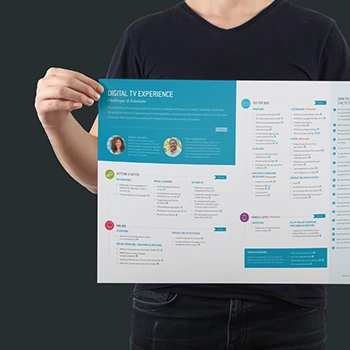What exactly is AI UX research and why do tech companies need it?
AI UX research helps you deeply know your users and how they use your AI-driven digital applications. Creating human-centered AI is simpler when you understand who your users are and how they behave with AI-driven experiences. We conduct AI UX research that uncovers specific insights into your AI ecosystem - whether they are customers, users, or partners. Through our Experience Thinking framework, we examine how users interact with AI across brand touchpoints, content consumption, product features, and service interactions to understand the complete AI experience journey.
Tip: Start AI UX research early in your AI development process rather than waiting until AI features are built to understand user needs and behaviors.
How does AI UX research differ from traditional user experience research?
AI UX research requires specialized methodologies that examine user trust in automated systems, acceptance of AI recommendations, understanding of AI decision-making, and adaptation to intelligent interfaces over time. Unlike traditional UX research that focuses on static interactions, AI UX research studies how users build mental models of AI behavior, develop confidence in AI systems, and change their task strategies when AI assistance is available. We examine both explicit user actions and implicit behavioral changes that occur with AI exposure.
Tip: Plan for longitudinal AI research studies that track user behavior changes over weeks or months rather than single-session testing typical in traditional UX research.
What makes Akendi's approach to AI UX research unique?
Our Experience Thinking framework elevates AI UX research by examining how users experience AI across all four quadrants: brand interactions with AI, content personalized by AI, product features powered by AI, and service delivery enhanced by AI. This holistic approach reveals how AI affects the complete user journey rather than just individual AI features. We study how users develop relationships with AI systems over time, from initial awareness through becoming loyal advocates of AI-enhanced experiences.
Tip: Research AI impact across all customer touchpoints rather than focusing only on specific AI features to understand the complete user experience transformation.
When should we conduct AI UX research in our product development cycle?
AI UX research should begin before AI development starts, continue during prototyping and development, and extend after launch to understand long-term user adaptation. Early research identifies user needs that AI should address, development-phase research validates AI concepts and interactions, and post-launch research reveals how users actually adopt and adapt to AI features in real-world contexts. Each phase requires different research methods and objectives.
Tip: Budget for ongoing AI UX research rather than one-time studies, as user relationships with AI evolve significantly over extended usage periods.
What types of users should we include in AI UX research?
AI UX research should include current users, potential users, AI-enthusiastic users, AI-skeptical users, domain experts, and novice users to understand the full spectrum of AI adoption and resistance. Through our Experience Thinking approach, we examine how different user segments experience AI across brand, content, product, and service touchpoints. This reveals how AI affects user journey progression from customer to user to loyal client differently for various user types.
Tip: Include AI-resistant or skeptical users in research to understand adoption barriers and design AI experiences that work for cautious users, not just enthusiastic early adopters.
How do you research user trust and acceptance of AI systems?
User trust research examines how people develop confidence in AI through transparency, control, accuracy, and consistent behavior over time. We study what explanations users need for AI decisions, how much control they want over AI automation, and what factors build or erode trust in AI systems. Our research reveals the balance between AI capability and user comfort, helping design trustworthy AI that users will actually rely on in critical tasks.
Tip: Research trust-building progressively, starting with low-risk AI interactions and gradually introducing higher-stakes AI decisions as users build confidence.
What role does foresight design play in AI UX research?
Foresight design in AI UX research helps anticipate how user needs and behaviors will evolve as AI capabilities advance. We use scenario-based research to understand how users might interact with future AI features, explore user preferences for different AI development paths, and identify emerging user needs that current AI research might miss. This forward-thinking approach ensures AI development addresses not just current user needs but anticipated future requirements.
Tip: Include future scenario exploration in AI research to understand user preferences for AI evolution rather than just current AI feature acceptance.
What research methods work best for understanding AI user behavior?
AI UX research combines traditional methods with AI-specific techniques including algorithm transparency studies, AI interaction diaries, trust calibration testing, and longitudinal AI adoption studies. We use contextual inquiry to understand how AI fits into real workflows, behavioral analytics to measure AI usage patterns, and interview methods designed to uncover user mental models of AI behavior. Each method reveals different aspects of the human-AI interaction experience.
Tip: Combine behavioral observation with attitude measurement in AI research, as what users say about AI often differs from how they actually behave with AI systems.
How do you conduct user interviews about AI experiences?
AI user interviews require specialized techniques that help users articulate their often-unconscious responses to AI systems. We use scenario-based questioning, think-aloud protocols during AI interactions, and retrospective interviews that examine how users' AI perceptions change over time. Our Experience Thinking approach explores how AI affects users across brand, content, product, and service experiences, revealing the complete impact of AI on user relationships with organizations.
Tip: Use specific AI interaction examples during interviews rather than abstract AI questions to get concrete insights about user preferences and concerns.
What observational research methods reveal AI usage patterns?
Observational AI research includes screen recording during AI interactions, workflow shadowing to understand AI integration into daily tasks, and ethnographic studies that reveal how AI affects user behavior in natural environments. We observe both direct AI interactions and indirect behavioral changes that occur when AI is available. This reveals the full scope of AI impact on user experience and task completion strategies.
Tip: Observe users in their natural work environment rather than controlled lab settings to understand how AI actually integrates into real workflows and decision-making processes.
How do you test AI prototypes and concepts with users?
AI prototype testing examines both functional performance and user acceptance through scenario-based testing, comparative concept evaluation, and iterative feedback cycles. We test AI accuracy, response timing, explanation quality, and user control mechanisms to ensure AI concepts meet both technical and experiential requirements. Our testing reveals whether users understand, trust, and want to use proposed AI features in their actual work contexts.
Tip: Test AI prototypes with realistic data and scenarios rather than perfect demo conditions to understand how AI performs and is perceived in real-world uncertainty.
What survey methods work for AI user experience research?
AI surveys require specialized instruments that measure trust, perceived AI capability, user control preferences, and AI adoption intentions across different contexts. We develop surveys that track changes in AI perception over time, compare user preferences across different AI approaches, and identify user segments with different AI adoption patterns. Surveys complement qualitative methods by providing quantitative validation of AI user experience patterns.
Tip: Include AI literacy and prior AI experience questions in surveys to understand how user background affects AI perception and adoption willingness.
How do you conduct competitive AI research and analysis?
Competitive AI research examines how users experience AI implementations across different organizations and platforms. We study user preferences for different AI approaches, analyze competitive AI feature adoption, and identify AI experience gaps that create market opportunities. This research reveals what AI features users expect based on other AI experiences and where your AI implementation can differentiate through superior user experience.
Tip: Study AI implementations outside your industry to identify AI interaction patterns and user expectations that might inform your AI development approach.
What methods help understand AI accessibility and inclusion needs?
AI accessibility research examines how AI affects users with different abilities, technology comfort levels, cultural backgrounds, and domain expertise. We study how AI can enhance accessibility through adaptive interfaces while ensuring AI systems remain usable for everyone. Research includes voice AI testing with users who have motor impairments, visual AI testing with users who have vision differences, and cognitive AI support testing with users who have different processing needs.
Tip: Include accessibility considerations from the beginning of AI research rather than retrofitting accessibility into AI systems after development completion.
How do you analyze qualitative data from AI user research?
AI qualitative analysis examines user mental models of AI behavior, trust development patterns, adaptation strategies, and emotional responses to AI interactions. We analyze how users describe AI experiences across the Experience Thinking framework - brand AI interactions, content personalization responses, product AI feature usage, and service AI assistance. Analysis reveals both explicit user feedback and implicit behavioral changes that indicate AI acceptance or resistance.
Tip: Look for gaps between what users say about AI and how they actually behave with AI systems, as conscious attitudes often differ from unconscious usage patterns.
What quantitative metrics matter most in AI UX research?
AI UX metrics include traditional usability measures plus AI-specific indicators like prediction accuracy satisfaction, personalization relevance ratings, AI feature adoption rates, trust calibration scores, and long-term AI engagement patterns. We track how AI affects task completion efficiency, error recovery, user confidence, and willingness to rely on AI for different types of decisions. Metrics reveal whether AI truly improves user outcomes rather than just demonstrating technical capability.
Tip: Balance AI performance metrics with user experience quality measures, as technically accurate AI may still create poor user experiences if not well-designed.
How do you identify patterns in AI user behavior data?
AI behavior pattern analysis examines usage sequences, feature adoption timelines, error patterns, and adaptation trajectories across different user segments. We identify common paths users take when learning AI systems, typical failure points that cause AI abandonment, and successful AI integration patterns that lead to continued usage. Pattern analysis reveals design opportunities and user support needs that aren't obvious from individual user feedback.
Tip: Analyze AI usage patterns across extended time periods rather than short sessions to understand how user relationships with AI develop and change over months of usage.
What statistical methods work best for AI research analysis?
AI research statistics require methods that handle longitudinal data, user adaptation effects, and complex interaction patterns between users and AI systems. We use mixed-effects modeling to account for individual differences in AI adoption, time-series analysis to understand AI learning curves, and clustering analysis to identify distinct user segments with different AI preferences. Statistical methods reveal significant patterns in noisy AI usage data.
Tip: Account for individual differences in AI comfort and experience when analyzing research data, as user background significantly affects AI research results.
How do you synthesize insights from multiple AI research methods?
AI research synthesis combines behavioral data, interview insights, survey results, and observational findings to create holistic understanding of user-AI relationships. We triangulate findings across methods to validate insights, identify contradictions that require further investigation, and develop user models that predict AI adoption success. Synthesis reveals the complete picture of how users experience AI across different contexts and time periods.
Tip: Use multiple research methods to validate AI findings, as single-method AI research often misses important aspects of complex user-AI relationships.
What tools help manage and analyze AI research data?
AI research data management requires tools that handle multiple data types, longitudinal tracking, and complex user journey analysis. We use specialized research platforms for AI interaction logging, qualitative analysis software for interview coding, statistical packages for behavioral pattern analysis, and visualization tools for presenting complex AI findings to stakeholders. Tool selection depends on research scope, data volume, and analysis requirements.
Tip: Plan for data integration across multiple research tools rather than analyzing AI research data in isolation, as the most important insights often emerge from combining different data sources.
How do you create user personas for AI-enhanced products?
AI user personas include traditional demographic and behavioral information plus AI-specific attributes like technology comfort, AI experience level, automation preferences, and trust-building needs. Through our Experience Thinking framework, we examine how different personas experience AI across brand interactions, content consumption, product usage, and service delivery. Personas reveal how AI should adapt to different user types rather than assuming one AI approach works for everyone.
Tip: Include AI literacy levels and prior AI experience in personas, as these factors significantly affect how users adopt and interact with new AI features.
What user journey mapping approaches work for AI experiences?
AI journey mapping tracks how users discover, evaluate, adopt, and integrate AI features into their workflows over extended time periods. We map both the functional journey of learning AI capabilities and the emotional journey of building trust and confidence in AI systems. Journey maps reveal critical moments where users decide to embrace or abandon AI features, helping design interventions that support successful AI adoption.
Tip: Map AI user journeys over months rather than days to capture the extended process of AI adoption, trust development, and workflow integration.
How do you understand user mental models of AI systems?
User mental model research examines how people conceptualize AI behavior, capabilities, and limitations. We study what users think AI can and cannot do, how they explain AI decisions to themselves, and what analogies they use to understand AI systems. Mental model research reveals misalignments between user expectations and actual AI capabilities, helping design AI interactions that match user understanding or gently correct misconceptions.
Tip: Research both accurate and inaccurate user mental models of AI, as incorrect assumptions about AI capabilities often drive user frustration and abandonment.
What motivates users to adopt and use AI features?
AI adoption motivation research examines both functional benefits (efficiency, accuracy, convenience) and emotional factors (curiosity, status, control) that drive AI usage. Through Experience Thinking principles, we understand how AI motivation varies across brand engagement, content interaction, product usage, and service experiences. Research reveals that AI adoption often depends more on perceived value and trust than technical sophistication.
Tip: Focus on user-perceived AI value rather than technical AI capabilities when designing AI adoption strategies, as users adopt AI for benefits they understand and care about.
How do you research user resistance and barriers to AI adoption?
AI resistance research examines both rational concerns (privacy, accuracy, job displacement) and emotional barriers (fear, confusion, loss of control) that prevent AI adoption. We study how resistance varies across user segments, contexts, and AI applications to design approaches that address specific barriers rather than general AI promotion. Understanding resistance helps create AI experiences that work for skeptical users, not just AI enthusiasts.
Tip: Treat AI resistance as valuable user feedback about AI design rather than just obstacles to overcome through education or persuasion.
What user needs does AI research typically uncover?
AI research reveals both explicit user needs (faster task completion, better recommendations, reduced errors) and implicit needs (maintaining control, understanding decisions, building confidence). Users often need AI transparency to build trust, AI customization to match their preferences, and AI fallbacks when automation fails. Research shows users want AI that enhances their capabilities rather than replacing their judgment in important decisions.
Tip: Research both functional AI needs and emotional AI needs, as successful AI adoption requires addressing user feelings about automation, not just functional requirements.
How do you segment users based on AI preferences and behaviors?
AI user segmentation examines technology adoption patterns, automation preferences, trust development approaches, and AI usage contexts to identify distinct user groups with different AI needs. Segments might include AI early adopters, cautious adopters, domain experts who want AI augmentation, and novices who need AI guidance. Segmentation helps design differentiated AI experiences rather than one-size-fits-all approaches.
Tip: Segment users based on AI attitudes and behaviors rather than just demographics, as AI preferences often transcend traditional user categories.
How do you scope and plan AI UX research projects?
AI research planning begins with understanding your AI development timeline, user base complexity, business objectives, and technical constraints. We develop research plans that balance depth and breadth, selecting methods that provide actionable insights within your development schedule. Planning includes participant recruitment strategies, data collection timelines, analysis approaches, and stakeholder communication schedules that align with AI development milestones.
Tip: Plan AI research with longer timelines than traditional UX research to accommodate user learning curves and the need for longitudinal data collection.
What budget considerations apply to AI UX research?
AI UX research requires budget allocation for specialized methods, longitudinal studies, diverse participant recruitment, advanced analysis tools, and ongoing research support throughout AI development. Costs include participant compensation for extended studies, technology for AI interaction recording, specialized research tools, and expert analysis of complex AI behavior patterns. Investment in thorough AI research typically reduces development costs by identifying issues early.
Tip: Budget for iterative AI research cycles rather than single studies, as AI development benefits from continuous user feedback and validation throughout the process.
How do you recruit participants for AI research studies?
AI research recruitment targets users with varying AI experience levels, different domain expertise, diverse technical comfort, and different automation preferences. We recruit through multiple channels to ensure participant diversity, screen for relevant AI experience, and balance enthusiasts with skeptics. Recruitment includes current users, potential users, competitors' users, and non-users to understand the complete spectrum of AI adoption potential.
Tip: Screen participants for both AI experience and domain expertise, as these factors significantly affect how users evaluate and adopt AI features in your specific context.
What timeline works best for AI UX research projects?
AI research timelines accommodate user learning curves, trust development, and behavioral adaptation that occur over weeks or months rather than hours or days. Early research phases focus on understanding current user needs and AI opportunities, middle phases test AI concepts and prototypes, and later phases evaluate AI adoption and optimization needs. Timeline planning includes buffer time for unexpected findings that require additional investigation.
Tip: Plan AI research timelines with flexibility to accommodate unexpected findings that may require pivoting research focus or extending data collection periods.
How do you align AI research with development sprints and processes?
AI research alignment requires understanding your development methodology, sprint schedules, milestone requirements, and stakeholder decision-making processes. We structure research deliverables to provide actionable insights when development decisions need to be made, coordinate with development cycles to validate AI concepts before implementation, and provide ongoing research support during AI development phases.
Tip: Integrate AI research checkpoints into development sprints rather than conducting research separately from development, ensuring research insights inform development decisions when they matter most.
What stakeholder involvement works best in AI research?
AI research stakeholder involvement includes product managers who understand business objectives, developers who know technical constraints, designers who need user insights, and business leaders who make strategic decisions. We facilitate stakeholder participation in research planning, observation sessions, insight synthesis, and recommendation development to ensure research addresses real organizational needs and builds support for user-centered AI development.
Tip: Include both technical and business stakeholders in AI research to ensure findings address both user needs and organizational capabilities for AI implementation.
How do you handle ethical considerations in AI user research?
AI research ethics include informed consent about AI data usage, participant privacy protection during AI interactions, transparent communication about research purposes, and careful handling of sensitive user behavior data. We ensure participants understand how their AI interaction data will be used, provide opt-out mechanisms for uncomfortable AI testing, and maintain strict data security throughout the research process.
Tip: Address AI research ethics proactively with clear participant communication and robust data protection rather than assuming standard research ethics cover AI-specific concerns.
How do you present AI research findings to development and business stakeholders?
AI research presentation combines user behavior evidence, statistical analysis, visual data representations, and actionable recommendations tailored to different stakeholder needs. We create executive summaries for business leaders, detailed findings for designers and researchers, technical implications for developers, and strategic recommendations for product managers. Presentations include user quotes, behavior videos, and data visualizations that make AI research findings compelling and memorable.
Tip: Customize AI research presentations for different audiences rather than using one-size-fits-all reports, as stakeholders need different levels of detail and focus areas.
What formats work best for sharing AI user research insights?
AI research formats include written reports with detailed findings, visual presentations for stakeholder meetings, persona documents for design reference, journey maps for experience planning, and recommendation frameworks for development prioritization. We create formats that support different usage contexts - from quick reference during development decisions to detailed analysis for strategic planning. Format selection depends on stakeholder needs and organizational communication preferences.
Tip: Create multiple AI research deliverable formats rather than just detailed reports, as different stakeholders consume and apply research insights in different ways.
How do you ensure AI research insights influence product development decisions?
Research influence requires translating user insights into specific AI development recommendations, connecting findings to business objectives, and maintaining stakeholder engagement throughout the development process. We provide ongoing consultation during AI development, help interpret research findings when development questions arise, and validate development decisions against research insights to ensure user needs remain central to AI implementation.
Tip: Maintain ongoing engagement with development processes rather than just delivering research reports, as AI development benefits from continuous research consultation and insight application.
What ongoing support do you provide after delivering research findings?
Post-research support includes helping interpret findings during development, providing additional analysis when new questions arise, validating development decisions against research insights, and conducting follow-up studies to evaluate AI implementation success. We offer consultation during design and development phases, help communicate research insights to new stakeholders, and provide guidance for applying research findings to specific AI development challenges.
Tip: Plan for ongoing research consultation during AI development rather than treating research as a one-time deliverable, as development questions and needs evolve throughout AI implementation.
How do you measure the impact of AI UX research on product success?
Research impact measurement tracks how insights influence AI development decisions, user satisfaction with implemented AI features, business metrics affected by AI research recommendations, and long-term user adoption of AI features designed based on research findings. We help establish success metrics before research begins and track outcome improvements that can be attributed to research-informed AI development.
Tip: Establish baseline metrics before AI research begins and track specific outcomes that can be connected to research recommendations rather than just measuring general product success.
What training do you provide for internal professionals to apply AI research insights?
AI research training helps internal professionals understand how to interpret research findings, apply insights to AI development decisions, conduct basic AI user validation, and maintain user-centered focus throughout AI development. Training covers research methodology, insight application, user advocacy techniques, and collaborative approaches that help non-researchers contribute to user-centered AI development.
Tip: Focus AI research training on practical application rather than research methodology, helping internal professionals use research insights effectively rather than conduct research themselves.
How do you help organizations build internal AI research capabilities?
Internal capability building includes establishing AI research processes, training staff in AI-specific research methods, creating research tools and templates, and developing organizational practices that support ongoing user-centered AI development. We help organizations develop sustainable research capabilities that continue providing user insights after external research projects conclude, including mentorship for internal researchers and frameworks for ongoing AI user validation.
Tip: Focus capability building on sustainable processes and practical tools rather than just training, ensuring organizations can continue AI research effectively after external support ends.
What business outcomes does AI UX research typically drive?
AI UX research drives improved user adoption of AI features, reduced development costs through early issue identification, increased user satisfaction with AI interactions, higher user retention through better AI experiences, and competitive advantages through superior AI user understanding. Research helps organizations build AI features that users actually want and use rather than technically impressive AI that users abandon.
Tip: Track both adoption metrics and user satisfaction measures to understand AI research impact, as technical AI success doesn't always translate to user acceptance and business value.
How does AI research help reduce development risks and costs?
AI research reduces development risks by identifying user acceptance issues before development, revealing technical requirements based on user needs, uncovering usability problems that would cause AI abandonment, and validating AI concepts before significant development investment. Early research prevents costly development of AI features that users won't adopt or use effectively in real-world contexts.
Tip: Invest in early-stage AI research to avoid expensive development pivots later, as changing AI systems after development is significantly more costly than getting user requirements right initially.
What competitive advantages does AI UX research create?
AI research competitive advantages include deeper user understanding that informs better AI design decisions, faster AI adoption through user-centered implementation, differentiated AI experiences that users prefer over competitors, and market insights that identify AI opportunities competitors miss. Organizations with superior AI user research can build AI features that users actually want rather than just technically possible features.
Tip: Focus AI research competitive advantages on user experience differentiation rather than just AI technical capabilities, as superior user understanding creates more sustainable competitive positions.
How does AI research improve user satisfaction and retention?
AI research improves satisfaction by ensuring AI features meet real user needs, designing AI interactions that build rather than erode trust, creating AI experiences that enhance rather than complicate user workflows, and identifying AI applications that provide genuine user value. Research-informed AI development creates positive user experiences that encourage continued engagement rather than AI features that users avoid or abandon.
Tip: Measure user satisfaction with AI features separately from overall product satisfaction, as poor AI experiences can negatively impact entire user relationships with your organization.
What role does AI research play in scaling AI across organizations?
AI research scaling involves understanding how AI adoption patterns vary across user segments, identifying successful AI implementation approaches that can be replicated, developing AI design principles based on user research findings, and creating user-centered AI development processes that work across different product areas. Research provides the user understanding foundation that enables successful AI scaling beyond initial implementations.
Tip: Document AI research insights as reusable principles and guidelines rather than project-specific findings to support AI scaling across multiple products and contexts.
How does foresight design in AI research help prepare for future user needs?
Foresight design research explores how user expectations and behaviors might evolve as AI capabilities advance, identifying emerging user needs that current AI research might miss, and preparing organizations for future AI adoption challenges and opportunities. This forward-thinking approach helps organizations build AI capabilities that remain relevant as user expectations and AI technology evolve together.
Tip: Include future scenario exploration in AI research planning to understand not just current user needs but how AI user relationships might evolve over the next few years.
How is artificial intelligence changing the field of user experience research itself?
Artificial intelligence is transforming UX research through automated data analysis, pattern identification in large datasets, research participant matching, insight synthesis support, and predictive user modeling. AI can accelerate research analysis, identify patterns human researchers might miss, and scale research capabilities. However, human insight, empathy, and strategic thinking remain essential for interpreting AI-generated research insights and making user-centered design decisions.
Tip: Use AI as a research enhancement tool rather than replacement, leveraging AI capabilities for data processing while maintaining human researchers for insight interpretation and strategic decision-making.












